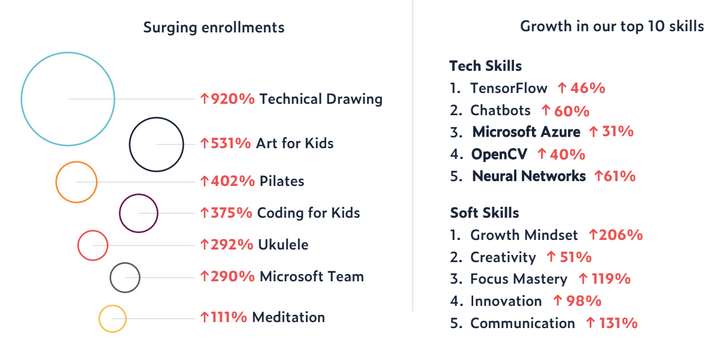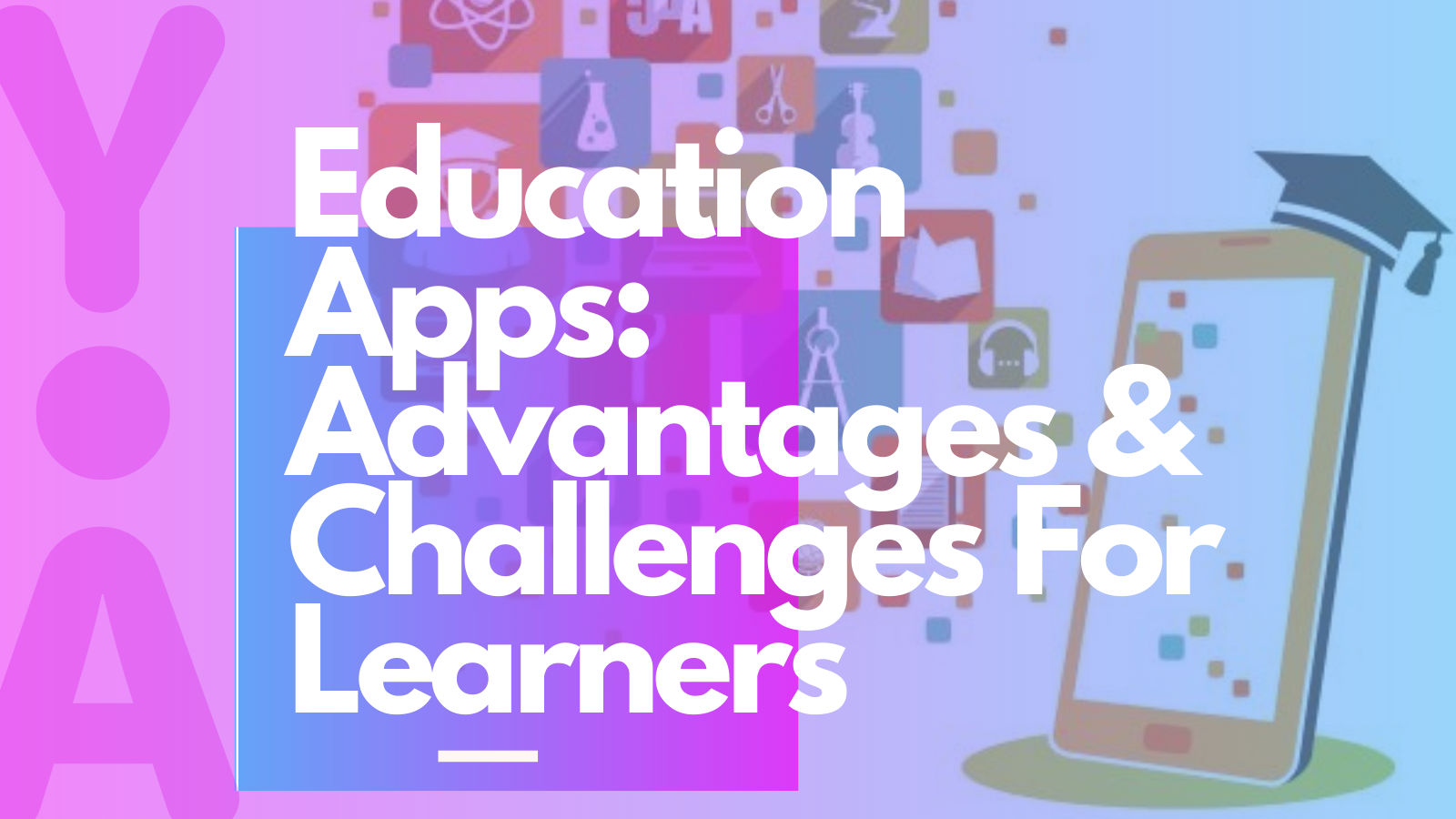“School’s out for summer!” For kids, these four words mean endless days out playing with friends, ice cream in the hot sun and best of all, no school to attend five days a week. However, an unstructured summer break can cause stress for parents. This is where education apps come to the rescue.
Education apps are a way to stimulate student’s minds while keeping them entertained with fun gamification and creative learning techniques. These apps have been on the rise in the last few years with a growth rate of over 24% between 2015 and 2020, which can be attributed to the growth of smartphones in younger generations alongside in home learning needs due to covid-19 pandemic limiting in person classrooms for quite a few years within this time frame. Udemy, an online learning and teaching marketplace, saw a 425% increase in online course enrollments in just 2021. This is most likely related to the now normal school required cycle of covid quarantine if any person in the classroom tests positive for the virus. With the rise of these apps, what was once only feasible within the four walls of a classroom can now be accessible nearly everywhere.

Source: Venture Beat
While in-person learning is still highly important to children’s social and emotional growth, education apps are a way to grab the attention of students in a way that they are familiar with. With 53% of American kids over 11 having their own smartphone and 84% of American teenagers, apps are an easy way to make education accessible to these kids and help them learn while in the convenience and “virus safe” space of their own homes.
Advantages of Education Apps
In a world where attention spans are lower than ever (with the average attention span only about to 8.25 seconds) educating youth through the use of apps is a way to feed knowledge to students through a device they are familiar with and already use on a daily basis. There are many advantages to education apps for student learning including accessibility, creativity, personalization and social media sharing.
Accessibility
Learning through mobile devices makes education much more convenient in terms of accessibility compared to in-person classes. Students no longer have to lug their heavy textbooks on road trips or in their duffel bags, since they can access ebooks and worksheets directly on their mobile device. With education apps, kids can learn from devices that they are already putting to use, so it's easy for them. Additionally, apps generate the opportunity for kids to learn at any time of the day. For example, if a student tends to learn best in the morning rather than in the middle of the day, they can log on during the time of day that suits their needs which can boost productivity.
It is important for developers to notice when their users are logging on to create custom notifications to best utilize this user behavior. Create personal messaging around the location they are in to invoke a sense of personalization, similar to how a teacher would ask questions.
Creativity
A critical aspect behind the success of education apps is creativity and gamification. Just because learning is through a smartphone does not mean that students will instantly gravitate towards the use of the app. Compared to adults, it is far more challenging to catch a child’s attention to learn on their own. Therefore, it is crucial to find ways to make learning fun and exciting.
Some apps are doing this by creating badges and point systems for students who successfully complete projects or assignments. These students can win “prizes” or other tokens as they go through the app. Other education apps are utilizing avatars that students can personalize to boost kids’ engagement. Progress bars, awards and leaderboards are all ways to create a game-like interface for student’s to get excited about their learning journey and stay focused. These are all ways that developers can make sure to retain their young users and make sure that they are creating long lasting relationships with their students.
Personalization Data
Do you remember most of your teachers growing up? I’m sure most of us remember at least one or two that made us feel special or empowered. With education apps, one on one personalization can be a bit tricky but is still extremely important. Not all students will learn or respond to new materials at the same pace, which with in-person learning, a teacher would most likely pick up on these cues. The key is to create that same atmosphere in a smartphone interface and utilize data that in-person teachers don’t have access to.
To personalize education apps, tracking a student’s pace on each assignment can be valuable to then learn if they are struggling with a lesson or subject or if they are advanced in another.. To apply this level of personalization, develop an algorithm that paces students differently based on timing, their scores, and feedback. It is important to check in with students after each learning block in order for them to self-assess their learnings to then move on to the next subject. Combine their assessments with the data gathered within the app to give a personalized element to each student. Personalizing learning in your education app will keep your young users engaged and able to learn at their own pace.
Social Media Sharing
Gen Z users, having grown up with smartphones, are fully immersed in the online world, averaging 4 hours and 15 minutes per day using their smartphones. Mainly, this age group is using their phones to socialize with friends and classmates. Education apps can tap into this heavy social media usage and incorporate social sharing into their platform. Students can share their triumphs and successes on their respective pages to show their classmates how well they are doing.
By having social media sharing as an option on your app, students will be more likely to stay and finish courses and assignments so that they can keep up with their friends. Creating a chat interface where students can collaborate with their peers is another way to draw students into the app.
Challenges for Education Apps
Education apps are an exciting and creative way to get students interested in learning outside of a classroom. However, there are many challenges that come with developing a successful education app including navigability, age group targeting, and finding a sense of success.
Navigability
Although gamification techniques are a great way to get student users excited about learning, adding too many features can be confusing. If the gamification side outweighs the educational involvement education apps could be in danger of not have kids take their learning seriously. Developers should focus on the app’s user interface before diving too deep into marketing. ake sure users won’t have a difficult time finding assignments or knowing where they should be focusing next.
Age Group Targeting
It can be challenging to create an app that works for all different age groups. Therefore, you need to identify your target audience first to then apply messaging, design and curriculum based on that target group, so that it's not only relevant and relatable, but also easily understood or digested by that group as well.Education apps have the ability to cover a wide range of students ,as early as kindergarteners all the way up to adults, or even seniors who might want to learn a new language. However, marketing and designing for each age group will be drastically different depending on the demographic you are focusing on.
Personalized Messaging
Age, location, curriculum and user behavior should all be integrated into the messaging for each individual user. If your app is aimed at younger children, keep messaging light and playful! This is where gamification really comes into play and works to retain these users. If you are focusing on adult education, it is best to steer away from games and prizes and focus on clear goals. Set notification reminders encouraging adult users that they are close to achieving their target in order to bring them back into the app. Focus group testing is a good way for developers to get a sense if their app is designed for the correct audience.
Sense of Success
Learning is a challenge! Regardless of age group, every student wants to feel a sense of accomplishment and success. For younger students, use videos and gifs to congratulate them on finishing a chapter or passing a test. With older users, the messaging can be as simple as telling them they are one step closer to hitting their goals!
Going Forward
While the pandemic is no longer the main driver behind education apps’ success, there is still much to come in this growing vertical. Teachers are adapting this technology into their coursework and using apps as a tool for their in-person classes. Parents are using educational apps as a way to keep their children engaged during the summer break and vacations. Adults can utilize these apps to learn new languages, brush up on their vocabulary, and so much more. Safe to say that we will be seeing many more of these helpful apps develop in the future!
Takeaways of Education Apps
Education apps are a way to stimulate student’s minds while keeping them entertained with fun gamification and creative learning techniques. These apps have been on the rise in the last few years with a growth rate of over 24% between 2015 and 2020. With 53% of American kids over 11 having their own smartphone and 84% of American teenagers, apps are an easy way to access these kids and help them learn while in the convenience of their own home.
Advantages of Education Apps
- Accessibility - Learning through mobile devices makes learning much more convenient in terms of accessibility compared to in-person classes. Students can learn from any place, at any time that is best for them. Developers can customize messaging around the location they are in to invoke a sense of personalization, similar to how a teacher would ask questions.
- Creativity - A critical aspect behind the success of education apps is creativity and gamification. Some apps are doing this by creating badges and point systems for students who successfully complete projects or assignments. These are ways that developers can make sure to retain their young users and make sure they are creating long-lasting relationships with their students.
- Personalization Data - With education apps, one-on-one support can be a bit tricky but is still extremely important. Not all students will learn at the same pace or should be given the same curriculum in a given period. Make sure that your app takes into account personal learning preferences of each young user.
- Social Media Sharing - Gen Z users, having grown up with smartphones, are fully immersed in the online world and spend an average of 4 hours and 15 minutes per day using their smartphones. Education apps can tap into this heavy social media usage and incorporate social sharing into their platform.
Challenges with Education Apps
- Navigability - Although gamification techniques are a great way to get student users excited about learning, adding too many features can be confusing. You want to make sure that your users don’t have a difficult time finding assignments or knowing where they should be focusing next.
- Age Group Targeting - It is important to know exactly who your target audience is and design your app accordingly.
- Personalized Messaging - If your app is aimed at children, keep messaging light and playful! If you are focusing on adult education, it is best to steer away from games and prizes and focus on clear goals.
- Sense of Success - Regardless of age group, every student wants to feel a sense of accomplishment and success. Make sure each user feels a sense of pride!

